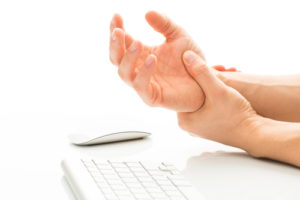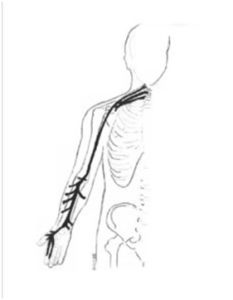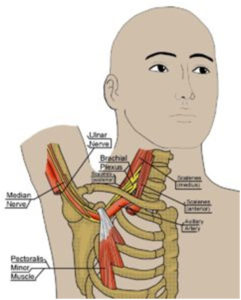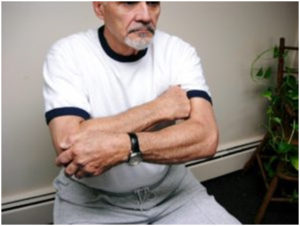What Causes Carpal Tunnel Syndrome – Part 2
Author: Julie Donnelly, LMT –The Pain Relief Expert
Editor: Dr. Steve Chaney
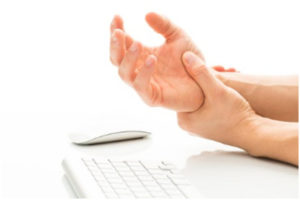 This month we will discuss treatment for carpal tunnel syndrome. However, let’s recap a little.
This month we will discuss treatment for carpal tunnel syndrome. However, let’s recap a little.
In last month’s article “What Causes Carpal Tunnel Syndrome” – Part 1 I shared how carpal tunnel syndrome almost destroyed my career as a massage therapist. I also shared that I rejected surgery and drew on all of my knowledge to devise a self-treatment program that cured my carpal tunnel syndrome symptoms.
Last month, I discussed the muscles and nerves in your neck, chest, and upper arm, and how they impinge on the median nerve and refer burning and tingling into your wrist and hand. This month the muscles we are discussing not only will cause burning and tingling, but will also cause pain in your wrist and hand. Plus, these muscles will put a strain on your carpal tunnel and will impinge on the nerve as it travels through your carpal tunnel. Fortunately, a simple treatment will release the tight muscles and take the pressure off the nerve.
I found the solution to my problem, and I’ve been bringing it to people worldwide ever since.
Treatment for Carpal Tunnel Syndrome: Forearm and Hand
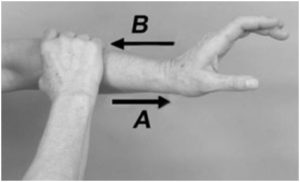 The muscles on the top of your arm (B) are called the Extensors.
The muscles on the top of your arm (B) are called the Extensors.
Your extensors originate at your elbow and insert into the carpal bones (back of your hand) and into your fingertips.
Your Flexor muscles (A) are on the underside of your forearm.
The flexors also originate at your elbow, they come down your forearm and merge into the tendon at your wrist. The tendons then go through your carpal tunnel and then insert into your hand and fingers.
When your hand is flat on a table and your extensors start to contract, you lift up your hand (B). But you can see that the flexors (A) on the underside of your forearm will need to lengthen to allow this movement.
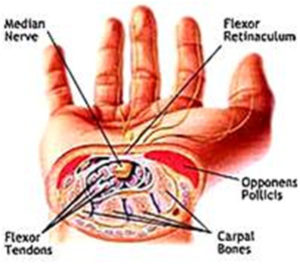 When your flexors are tight (commonly from repetitive movements), they won’t lengthen to allow your extensors to pick up your hand, and the taut flexor tendons may trap your median nerve in your carpal tunnel. This is a major cause of carpal tunnel syndrome because the nerve is being trapped right in the carpal tunnel. It was one of the primary keys to my symptoms, and an important part of the treatment for carpal tunnel syndrome.
When your flexors are tight (commonly from repetitive movements), they won’t lengthen to allow your extensors to pick up your hand, and the taut flexor tendons may trap your median nerve in your carpal tunnel. This is a major cause of carpal tunnel syndrome because the nerve is being trapped right in the carpal tunnel. It was one of the primary keys to my symptoms, and an important part of the treatment for carpal tunnel syndrome.
Why Muscle Tendons Cause Numbness In Your Fingers
As you look at this graphic you’ll see the flexor tendons surrounding the median nerve as they all pass through the carpal tunnel. Also, notice the carpal bones, which are where the extensor muscles attach. Finally, look at the thumb muscle called Opponens Pollicis . This muscle originates on the bridge to the carpal tunnel (called the Flexor Retinaculum), and when the muscle contracts you bring your thumb into the center of your palm.
The flexor retinaculum is the ligament that is severed during carpal tunnel release surgery. As you look at how close the median nerve is to the flexor retinaculum, you can see where a potential surgical mistake could sever the nerve. This accident disables the hand and isn’t reversible. Also, severing the flexor retinaculum means your thumb loses its base, and you lose strength.
This is the reason I refused surgery and sought a different carpal tunnel treatment.
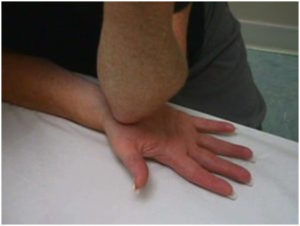 As I studied each muscle and saw how they each impacted the median nerve, I realized that if I released the spasms in each muscle that it would take the pressure off the nerve. And, sure enough, that’s exactly what happened!
As I studied each muscle and saw how they each impacted the median nerve, I realized that if I released the spasms in each muscle that it would take the pressure off the nerve. And, sure enough, that’s exactly what happened!
It took me about 90 minutes to figure this out (it will only take you 15 minutes to do all of the treatment for carpal tunnel syndrome to yourself), but in just that short amount of time I released ALL of the pain and numbness in my hand and wrist. I was beyond being thrilled — I saved my career!
Eventually I figured out how to put this entire process into my Basic Self-Treatment System DVD program to teach people all over the world how to eliminate the symptoms of carpal tunnel syndrome. I even developed a specialized tool to help people get the correct pressure and focus for each spasm.
A Simple Treatment for Carpal Tunnel Syndrome For Your Thumb
(Pictures and description are excerpts from The Julstro System for Hand/Wrist Pain and Numbness in my Carpal Tunnel Syndrome Book)
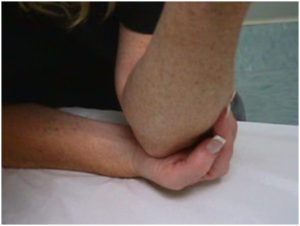 To release the spasms in your thumb muscle, place your opposite elbow into the thick portion of your thumb as shown in the picture to the left.
To release the spasms in your thumb muscle, place your opposite elbow into the thick portion of your thumb as shown in the picture to the left.
Step 2:
Use your fingertips to guide your elbow along the muscle. Move your elbow in a line from the center of your wrist to the base of your thumb.
Use sufficient pressure to really feel the muscle and the tender points which are spasms in the muscle fibers.
When you find a spasm, hold the pressure for 30 seconds and then deeply move back and forth a little bit.
If you are experiencing hand/wrist pain or numbness, before you make the decision to go for surgery it is worthwhile to read everything you can about muscles, numb fingers, and carpal tunnel pain relief in my Carpal Tunnel Syndrome book. You can’t undo surgery! So, try the treatment for carpal tunnel syndrome demonstrated here.
Wishing you well,
Julie Donnelly
About The Author
Julie Donnelly is a Deep Muscle Massage Therapist with 20 years of experience specializing in the treatment of chronic joint pain and
sports injuries. She has worked extensively with elite athletes and patients who have been unsuccessful at finding relief through the more conventional therapies.
She has been widely published, both on – and off – line, in magazines, newsletters, and newspapers around the country. She is also often chosen to speak at national conventions, medical schools, and health facilities nationwide.
These statements have not been evaluated by the Food and Drug Administration. This information is not intended to diagnose, treat, cure or prevent any disease.


